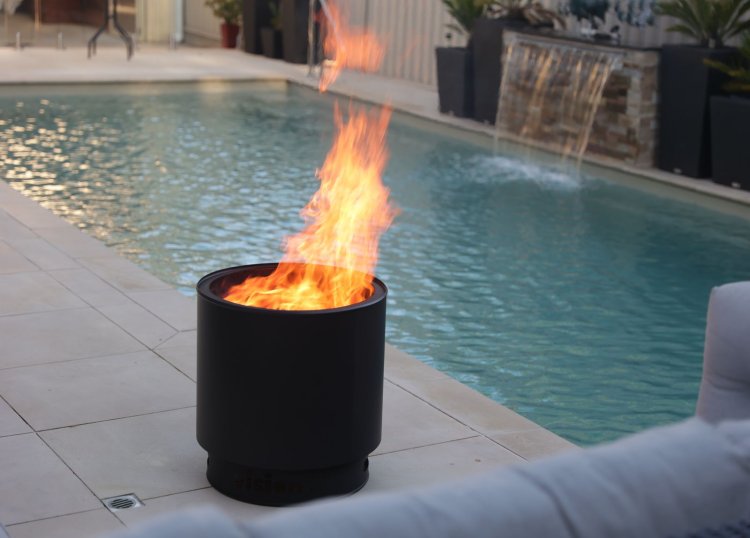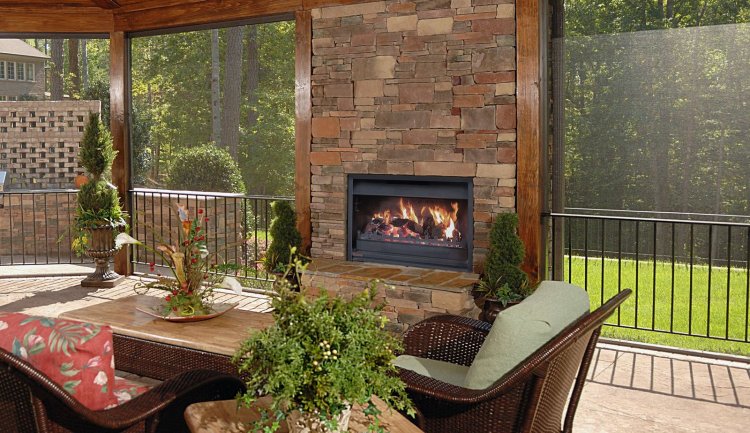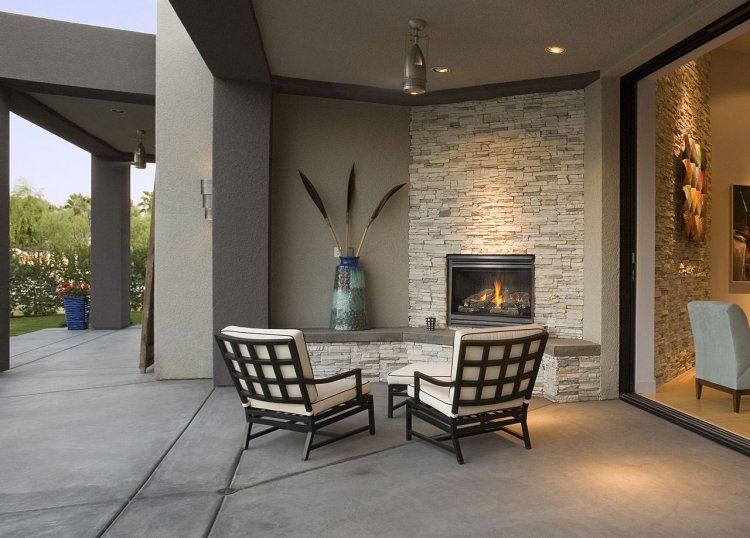-
-
Sales: 1300 219 875
-
Service: 1300 195 482

Do I go with a wood or gas fireplace?
If you’ve ever stood in your backyard, scratching your head and wondering which fireplace is right for your space, you’re not alone.
In this blog, we’re about to break down everything you need to know about wood and gas fireplaces – no jargon, no fluff, just straight-up, practical insights that’ll help you make the right choice for your home.
Before we get into the specifics of wood and gas fireplaces, let’s take a moment to appreciate why outdoor fireplaces have become such a popular addition to Australian homes.
There’s something undeniably magical about gathering around a fire in your own backyard. It creates a focal point for social gatherings, extends your living space into the outdoors, and provides warmth on those chilly nights when you’re not quite ready to head inside.
Whether you’re roasting marshmallows with the kids, sharing a bottle of wine with friends, or simply unwinding after a long day, an outdoor fireplace can elevate your outdoor experience and add value to your home.
Are you looking for outdoor fireplaces for your Launceston home? Our VisionLINE outdoor firepit is the perfect choice for smaller spaces. Its contemporary circular design acts as a spectacular centrepiece for your outdoor space. It can be moved simply and easily, and the handy carrying case means it can join you at the beach or while camping.

There’s no denying the primal appeal of a wood-burning fireplace. The crackling sounds, the dancing flames, and the smoky aroma all contribute to a sensory experience that many find irresistible. For those who cherish tradition and enjoy a hands-on approach to their home comforts, a wood fireplace can be incredibly satisfying.
Searching for the best outdoor wood fireplace?
Wood fireplaces can generate substantial heat, making them ideal for larger spaces or colder regions of Australia. The actual heat output depends on factors such as the type and quantity of wood used, as well as the design and efficiency of the fireplace.
When it comes to efficiency, open wood fireplaces are primarily valued for their ambiance rather than their heating performance, as a significant portion of the heat escapes through the chimney. On the other hand, slow-combustion wood stoves and inserts are designed to maximise heat retention, offering a more efficient heating solution. For those seeking a highly efficient and low-maintenance alternative, gas fireplaces provide consistent warmth with minimal heat loss.
Owning a wood fireplace requires a certain level of commitment. You’ll need to source, store, and stack firewood, which can be a time-consuming process. Additionally, wood fireplaces produce ash and soot, requiring regular cleaning and maintenance to keep them in top condition.
Also Read: How to Choose the Right Outdoor Wood Heater for Your Home

Gas fireplaces offer the allure of flames without the fuss. With the push of a button or the flip of a switch, you can have a roaring fire in seconds. This convenience is a major selling point for busy homeowners or those who prefer a low-maintenance outdoor living space.
Need gas fireplaces in Ballarat or Mornington Peninsula? Regardless of the design style of your space, we have a fireplace to match it. From our modern Heat & Glo Balanced Flue fireplaces to traditional styles, our selection is designed to captivate your senses while delivering heat.
Gas fireplaces are known for their consistency and efficiency. Small to medium gas fireplaces typically have a rating of around 4 to 7 kW per hour, while larger or high-efficiency models can range from 8 to 11 kW per hour or more. Gas fireplaces tend to be more efficient than wood-burning fireplaces, with efficiency ratings ranging from 60% to 90%.
From an environmental perspective, gas fireplaces produce fewer pollutants than wood fireplaces, making them a cleaner-burning option. This can be particularly important in urban areas where air quality regulations may be stricter.
One of the biggest advantages of gas fireplaces is their ease of use. There’s no need to chop or store wood, and cleanup is minimal. This makes them an attractive option for those who want to enjoy a fire without the associated chores.
You Might Also Like: Top 5 Features to Look for in Modern Fireplaces
To help you visualise the differences between wood and gas fireplaces, let’s break down their key features in a handy comparison table:
| Feature | Wood Fireplace | Gas Fireplace |
| Heat Output | 5-18 kW/hour | 4-11+ kW/hour |
| Efficiency | 10-30% (open), up to 85% (enclosed models) | 60-90% |
| Fuel Source | Firewood | Natural gas or LPG |
| Maintenance | Regular cleaning, ash removal | Minimal cleaning, annual service |
| Ambience | Natural crackling, smoky aroma | Consistent flame, no smoke |
| Convenience | Requires wood preparation | Instant on/off |
| Environmental Impact | Higher emissions | Lower emissions |
| Cost | Ongoing fuel costs vary | Consistent fuel costs |
When deciding between a wood and gas outdoor fireplace, consider the following factors:
Wood fireplaces generally require more space for the fireplace itself and wood storage. They can be designed to complement various architectural styles, from rustic to contemporary.
On the other hand, gas fireplaces are often more compact and can be installed in smaller spaces. They offer flexibility in design and can be customised to fit modern or traditional aesthetics.
Before making a decision, check your local council regulations regarding outdoor fireplaces. Some areas may have restrictions on wood-burning fireplaces due to air quality concerns.
Consider the availability and cost of firewood in your area versus the accessibility of natural gas or LPG. In some regions of Australia, one fuel source may be more readily available or cost-effective than the other.
If you live in a colder part of Australia or plan to use your fireplace frequently, a wood-burning fireplace might provide more heat. However, if you’re in a milder climate or want occasional ambience, a gas fireplace could be more suitable.
Do you enjoy the ritual of building and tending a fire, or do you prefer the convenience of instant flames? Your lifestyle and personal preferences should play a significant role in your decision.
Regardless of which type of fireplace you choose, proper installation and adherence to safety standards are crucial. In Australia, there are specific regulations for both wood and gas fireplaces that must be followed:
Check Out: Are Wood Burning Fireplaces Really Safe?
After considering all the factors, you may still find yourself torn between the rustic charm of a wood fireplace and the modern convenience of a gas fireplace. Here’s a final breakdown to help you decide:
Choose a wood fireplace if:
Choose a gas fireplace if:
Whether you opt for the timeless appeal of a wood fireplace or the modern efficiency of a gas fireplace, adding an outdoor fireplace to your home is sure to enhance your living space and create lasting memories. Both options have their unique advantages, and the right choice depends on your specific needs, preferences, and lifestyle.
At Jetmaster, we understand that choosing the perfect outdoor fireplace is an important decision. That’s why we offer a wide range of both wood and gas fireplaces to suit every taste and requirement. Our expert team can guide you through the selection process, ensuring you find the ideal fireplace to complement your outdoor area and meet your heating needs.
Ready to transform your outdoor space with a stunning fireplace? Visit Jetmaster today to explore our extensive range of wood and gas fireplaces. Our knowledgeable staff can provide personalised advice, help you navigate local regulations, and provide a smooth installation process.
Contact us now to schedule a consultation and take the first step towards creating your perfect outdoor retreat.
Sales:1300 219 875
Services:1300 195 482